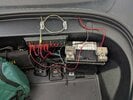Hi all,
I am in the planning stages of a mild audio system (800w to sub), but I really want to make sure this is done the right way. It may turn wild later with more power, but for now, it will be only a single AudioControl LC-1.800 amp.
Prior audio experience tells me that on most ICE cars suffering from charging problems due to current draw (dimming of lights), adding a second battery and a battery isolating relay is often an affordable and reliable solution. Being that our cars are particularly sensitive to current draw, has anyone successfully added a second battery yet? The Stinger data sheet shows how to do this in an ICE car. Looks easily doable on our cars as well, assuming we grab switched 12v off the center console LED.
I've seen the 30amp solid state relay with parallel 2.4 ohm 100-watt coil solution, but I don't like how solid state relays can generate a lot of heat, not to mention 30 amps just isn't enough for a high-powered stereo. The mechanical Stinger relay would not generate any heat at all, and the amplifier(s) will draw all of their current from the secondary 12v battery, and that battery would be slowly charged by the primary 12v battery.
I am in the planning stages of a mild audio system (800w to sub), but I really want to make sure this is done the right way. It may turn wild later with more power, but for now, it will be only a single AudioControl LC-1.800 amp.
Prior audio experience tells me that on most ICE cars suffering from charging problems due to current draw (dimming of lights), adding a second battery and a battery isolating relay is often an affordable and reliable solution. Being that our cars are particularly sensitive to current draw, has anyone successfully added a second battery yet? The Stinger data sheet shows how to do this in an ICE car. Looks easily doable on our cars as well, assuming we grab switched 12v off the center console LED.
I've seen the 30amp solid state relay with parallel 2.4 ohm 100-watt coil solution, but I don't like how solid state relays can generate a lot of heat, not to mention 30 amps just isn't enough for a high-powered stereo. The mechanical Stinger relay would not generate any heat at all, and the amplifier(s) will draw all of their current from the secondary 12v battery, and that battery would be slowly charged by the primary 12v battery.







